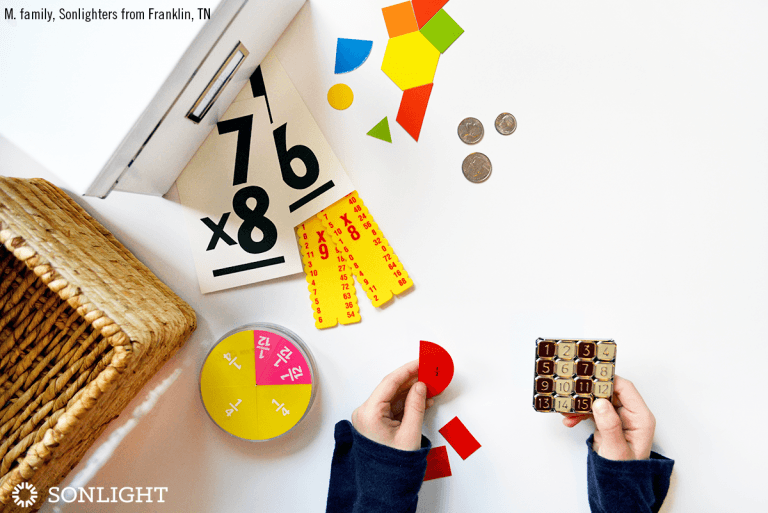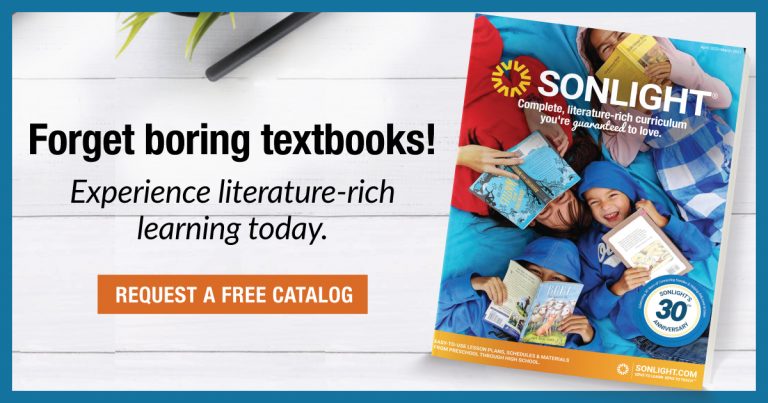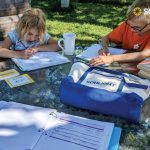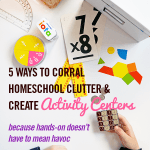When you run an entire school inside the same four walls where you also eat and sleep, there’s no shortage of stuff. Learning to corral the homeschool clutter is a necessary part of the homeschool lifestyle.
In our family, we homeschool—and work from home—in an open-plan second-floor apartment with no balcony. Phew! (“Open-plan” is a technical term best defined as, “no matter where you stand, you can still see everything.” You can’t close the door on the mess in an open-plan home!)

But for over a year now, our entire family has been on a quest to conquer clutter, organize our multipurpose space, and regain the time spent perpetually picking up. Is this your desire, too?
Here are a few organizational techniques we’ve been putting into practice.
1. Assess Whether or Not You Truly Need the Item
Decluttering is key. There are a lot of items we keep around without much thought, either because the item has always been there, or because we think we are somehow obligated to keep it. But do we actually use it? If not, it might be time to let it go. Belongings—even highly-reviewed educational tools—take up more space than they’re worth, if they remain unused. (And I’m referring to both physical and emotional space!)
Remember—and I’m talking to myself here as well—organized clutter is still clutter. Truly effective organizational systems allow us to easily and effectively access the items we use most often, not just mindlessly store all our belongings. Organization, while it takes dedication, persistence, and a good chunk of time doesn’t have to be expensive. There are a myriad of attractive, low-cost ways to streamline your homeschool.
2. Corral Homeschool Clutter with Inexpensive Boxes
A certain Scandinavian big-box retailer offers sturdy lidded boxes—they’re coated cardboard with metal accents; you actually assemble them with nuts and bolts—for under five dollars each. These are attractive, fit flush on a standard bookcase shelf, and hold up surprisingly well to daily use. I especially appreciate the muted colors—three or six of these boxes can transform an entire messy shelf of school supplies into a sleek storage area which no longer catches your eye. In our home, we use lidded boxes to store
- flashcards
- math wrap-ups
- loose crayons
- loose markers
- cables and chargers
- board books
Grouping like items together means fewer minutes lost searching for needed supplies when it’s time to start a project.
3. Sort Odd-Shaped or Frequently-Lost Items in Rectangular Baskets
You know those items that don’t shelve well, like board games and board books? Baskets are an ideal solution! I’ve found that the very most functional baskets to corral homeschool clutter aren’t decorative or curved, but are simple, strong, sturdy rectangles. A basket neatly slid underneath a bench, next to a couch, or at the foot of the bed is the perfect storage spot for
- library books
- board games
- chunky toddler books
- puzzles
- bulky toys
- sensory items
And a bonus? Designating a big basket as home base for library books results in far fewer fines. That’s a win we can all celebrate!
4. Temporarily Store Multi-step Projects on Serving Trays
At the end of each school day, we make it a priority to clear the table, so we can enjoy our dinner on a clear surface. I was sometimes—okay, often—met with protests when it came to putting away projects still in progress. But now, we put the project on a tray, slide the tray under the TV stand, and all the moving pieces are safe until the next day. This works really well for small jigsaw puzzles, too! Just make sure the trays don’t become permanent homes for forgotten messes.
5. Group Like Items Together into Themed Activity Centers
Many classrooms have themed centers, each focusing on a different activity. In lower-level classrooms, these centers might offer painting or sensory play, while in other classrooms you’ll see areas for math, writing, or STEM challenges.
You can borrow this idea from a traditional school setting and incorporate centers into your homeschool day! I like to create our own themed activity boxes, using lidded plastic shoe boxes. (Most dollar stores keep these in stock year-round.) Most afternoons, we have “center time,” which is just a fancy way of encouraging child-led exploration with different hands-on projects.
Some of our centers include
- art (smock, paint sticks, tablecloth, brushes)
- science (experiment supplies, rocks, batteries, wires, magnifying glass)
- puzzles (ziploc bags containing jigsaw pieces, small mazes, logic puzzles)
- money (loose change, foreign coins, play money)
- math (fraction sets, math manipulatives, multi-link cubes, base ten, tangrams, pattern blocks)
- handicrafts (needle, embroidery floss, nail scissors, cross stitch fabric)
- crafts (stickers, pom poms, pipe cleaners, beads, glitter glue, cardstock scraps)
- STEM (toothpicks, popsicle sticks, clay, rubber bands, cardboard).
This system is also very helpful when it comes to identifying items which need to be decluttered. If it doesn’t fit into a themed activity box, and no one is using it regularly -- time to purge!
While it’s easy to get overwhelmed with the sheer quantity of loose supplies it takes to create an exploratory learning environment, educational items don’t have to take over and rule your homeschool life. Remember, hands-on doesn’t need to equal havoc.
Being intentional and consistent about grouping like items, creating a designated home for each item, and letting go of unused or duplicate items can help you corral the homeschool clutter and transform your homeschool from a chaotic mess into a peaceful haven.
To find out more about Sonlight's unmatched Read-Alouds, and our complete book-based homeschool programs, order a complimentary copy of your catalog today.








